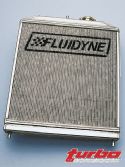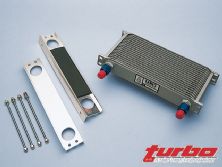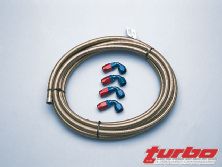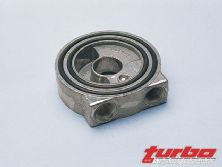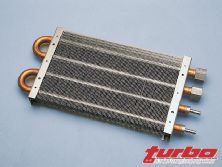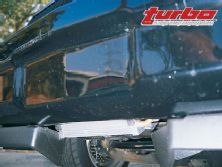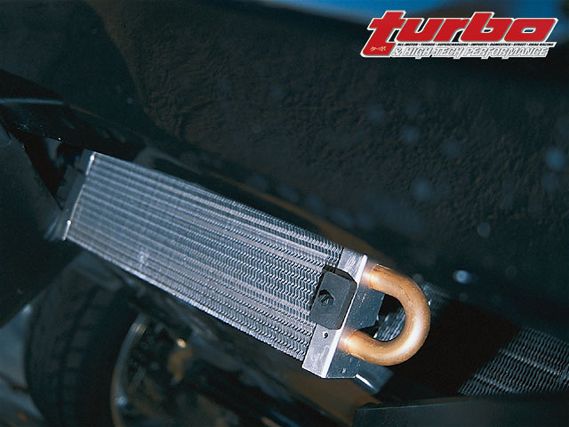 | As Power Rises So Does The Challenge Put To The Cooling System
| As Power Rises So Does The Challenge Put To The Cooling System Keeping your eye on the ball is a good thing, but it is also prudent to stand back and look at the big picture. All too often, enthusiasts become so focused on turning up the boost and/or unleashing a barrage of high power mods to their car they fail to consider the byproduct of their actions. It is wise to remember that as you make substantially more power than stock, you do so by burning substantially more fuel. Where there's fire, there's heat. With more fuel burning, there is an accompanying increase in heat.
Depending on the car in question, you may go a long way before taxing the cooling system, but beware: heat kills. A Honda has a cooling capacity designed for commuter duty. Turbocharging the engine and upgrading the injectors to the point of making 450 whp can easily overwhelm the OE cooling system. Also, remember as the ambient temperature rises, the cooling system's ability to fend off heat can lessen. A car that is borderline in the fall will be hurting in the heat of the summer.
An automotive engine cooling system consists of a water pump, radiator, cooling fan and an oil cooler. We like to throw in transmission cooling as well because the concept and benefits are very similar to engine cooling. Oil and tranny coolers are not part of cooling systems on all cars, but they should be.
The efficiency of the stock system and the intensity of the mods made to the engine will dictate which method of cooling system fortification is needed. For some, a fan upgrade will do the trick. An upgraded fan increases the radiator's efficiency by flowing more air through it, which is especially useful in stop-and-go traffic where the fan system earns its pay.
When things get really out of hand, as in the case of our 450-whp Honda, it's time to step up to a custom radiator. These units feature more rows of cooling passages and, in some cases, more effective fin designs. Don't get carried away with having too many rows because this is a decreasing dividend proposition.
As the cool air moves through the radiator it exchanges heat and as a result becomes warm. So by the time it gets to the last row the air's higher temperature means it has less cooling power in it than when it first contacted the radiator. The best solution is a larger surface area but space limitations in street cars make this option more difficult. A four-row radiator of a decent surface area should handle most cooling tasks.
The water pump is usually not an issue because the water flow rate is not really a problem. In fact, the longer the water is in the radiator, the more it is cooled-a win-win situation. In racing applications, an electric water pump may be employed, but this is done to eliminate the parasitic drag of the stock-style pulley driven pump.
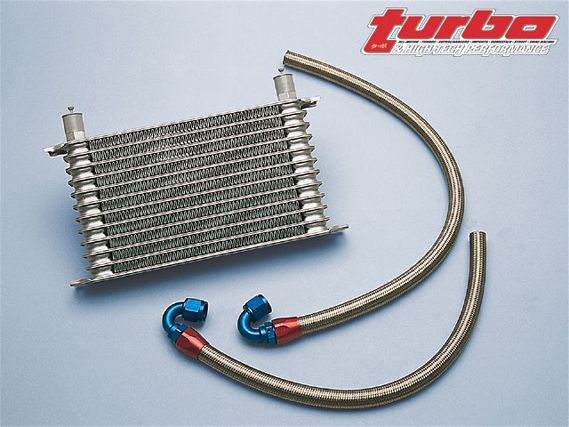 | This Blitz oil cooler is small enough to fit in the cramped confines of sport compact cars and deliver the proper cooling. The kit includes universal mounting bracketry and braided stainless-steel hoses.
| This Blitz oil cooler is small enough to fit in the cramped confines of sport compact cars and deliver the proper cooling. The kit includes universal mounting bracketry and braided stainless-steel hoses. Oil coolers are an often overlooked, yet extremely beneficial modification. It's all about longevity, and cooler oil will lubricate better, longer. This addition is more of a service life issue rather than a cooling issue. The resulting reduction in oil temperature will only reduce engine heat nominally.
Ditto transmission coolers on automatic transmissions. However, heat is the leading cause of death for automatics and an ounce of prevention will add miles to the life of your slush box.
There is a car that represents a "convergence of cooling" with all the correct ingredients but a rather poor execution. The Buick Grand National has a decently sized radiator, an electric cooling fan, and oil and transmission coolers in stock trim. The twist? The oil and tranny coolers are incorporated into the radiator.
In stock trim, the Buick runs an air-to-air intercooler mounted behind the radiator that cleverly uses a conventional clutch-driven fan to pull air through it. The stock GN cooling system is adequate but it can be saturated when the car is driven hard in the summer heat.
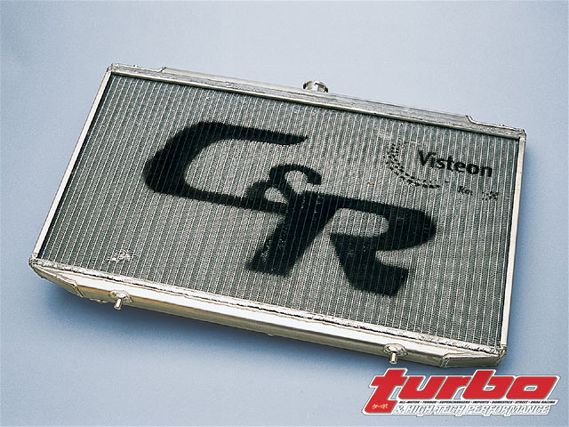 | As Power Rises So Does The Challenge Put To The Cooling System
| As Power Rises So Does The Challenge Put To The Cooling System A Kenne Bell front-mount intercooler was installed, boost was bumped from 14 to 17 psi and 40 lb/hr injectors were added to our Project Black Jack GN. These mods conspired to stress the cooling system. Freeway cruising would see temps of 80 to 85 Celsius, or about 180 Fahrenheit. After playing with a turbocharged IS300, temps climbed to between 95 and 100 Celsius, or 203 to 212 Fahrenheit. It wasn't all that hot out so clearly there were issues.
An all-out attack was unleashed on the Buick; it was a divide-and-conquer mission. The plan was to maximize radiator effectiveness by going to a four-row unit with no internal oil or tranny coolers. The radiator was 100 percent engine cooling with the oil coolers split to stand-alone units. C&R took delivery of a stock GN radiator and constructed a matching four-row unit that features more rows and much more efficient fins to further enhance its cooling capabilities. The C&R unit dropped in with the only modification made to the top plate.
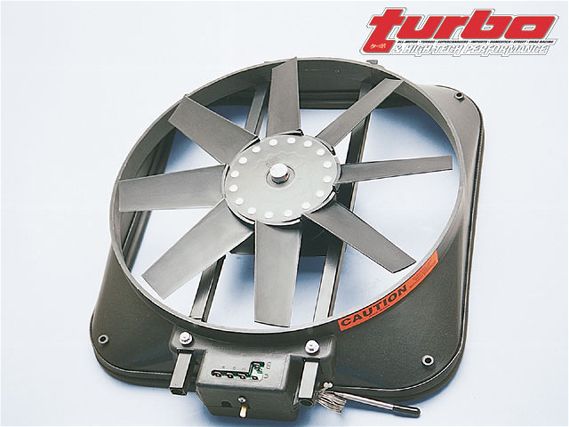 | We wanted a fan that could suck passing pedestrians through the grille. Flex-A-Lite had one. Its Black Magic 165 is a puller that flows a crazy 2800 cfm. Modern electric fans are quite high-tech, as evidenced by the 165's adjustable thermostat control and A/C cut-off that works seamlessly with today's ECUs.
| We wanted a fan that could suck passing pedestrians through the grille. Flex-A-Lite had one. Its Black Magic 165 is a puller that flows a crazy 2800 cfm. Modern electric fans are quite high-tech, as evidenced by the 165's adjustable thermostat control and A/C cut-off that works seamlessly with today's ECUs. In placing the oil and tranny coolers, the challenge was finding spots with good flow that were not too low,where the coolers could be damaged by debris. The consequences of such damage could be catastrophic engine failure. There was only one viable position that provided flow and did not further block the radiator. Flex-A-Lite came to the rescue with a dual-purpose unit that combined two coolers in one unit. While the unit is not in a direct stream of air, the flow it does get is enough to get the job done as the open fin design of the cooler needs minimal flow to function properly.
The last volley was a fan upgrade and we wanted a fan that could suck a pedestrian through the grille at stoplights. Flex-A-Lite had it covered with its Black Magic 165, a puller that flows a crazy 2800 cfm. Modern electric fans are quite high-tech as evidenced by the 165's adjustable thermostat control and A/C cut-off that blends seamlessly with today's ECUs.
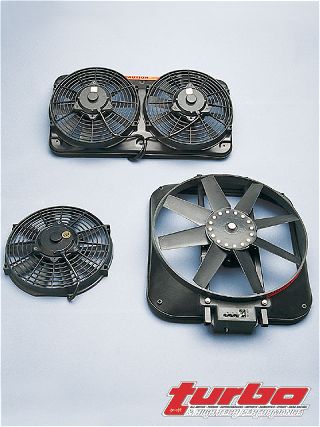 | Fans come in a variety of different configurations. Single or dual set-ups, different sizes, with and without shrouds and a multitude of cfm ratings can make it tough to chose. An important factor is thickness, especially if a turbo conversion is at hand. A thin-design fan can free up vital room needed for a turbo. Many companies also offer fans in different colors for the fashion conscious.
| Fans come in a variety of different configurations. Single or dual set-ups, different sizes, with and without shrouds and a multitude of cfm ratings can make it tough to chose. An important factor is thickness, especially if a turbo conversion is at hand. A thin-design fan can free up vital room needed for a turbo. Many companies also offer fans in different colors for the fashion conscious. The results were well worth the effort; freeway cruising temperatures are in the 158 degree F range, and with boost, the gauge slowly rises to the 190 degree F range but no further. We expect to see these numbers increase slightly when we upgrade from our stock turbo set up and put more of the 40 lb/hr injectors' capacity to use.
Engine cooling is important but in factory turbo and especially turbo conversion applications cooling upgrades can be critical to the driveability of the vehicle. So when you are laying the groundwork for a project build-up, along with the often-overlooked brake upgrade, consider the effects your proposed mods will have on the cooling system.
It's hard work generating big power. Ensure you can flex those muscles 24/7 in the hottest of heat waves by properly addressing cooling system performance.
CELSIUS TO FAHRENHEIT CONVERSION C F 70 158 80 176 85 185 {{{90}}} 196 95 203 100 212
